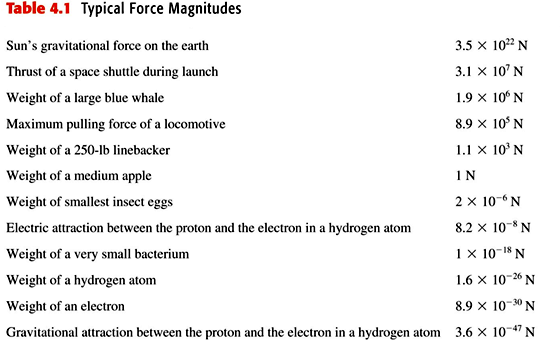| |
|
· To visualize force as a vector
|
· To find the net force acting on a body and apply Newton's First Law
|
· To study mass, acceleration, and their application to Newton's Second Law |
· To calculate weight and compare/contrast it with mass |
· To see action–reaction pairs and study Newton’s Third Law
|
| |
Newtonian Mechanics (牛顿力学):
|
Newton’s First Law: |
If there is no net force on a body, the body must remain at rest if it is initially at rest, or move in a straight line at constant speed if it is in motion.? For such a body, there are reference frames, called inertial frames (惯性系), from which the body’s acceleration a will be measured as being zero.? |
Newton’s Second Law:  |
 is the net force (净力) or resultant force (合力). is the net force (净力) or resultant force (合力).
A free-body diagram is helpful in solving problems with the second law: only one body is considered in the diagram.? That body is represented by a dot.? The external forces on the body are drawn as vectors, and a coordinate system is superimposed, oriented so as to simplify the solution.
|
define momentum (动量) General form: 
|
| |
We refer to the vector sum or resultant as the “sum of forces”? |
 |
|
|
Action force (作用力) and reaction force (反作用力) are equal in magnitude and opposite in direction.? They act on different bodies.? |
 |
| |
Some particular types of forces |
· The normal force (压力) —When an object rests or pushes on a surface, the surface pushes back. The normal force is always perpendicular to the surface. |
· Frictional force (摩擦力) —the force on a body when the body slides or attempts to slide along a surface. The force is parallel to the surface and directed so as to oppose the motion of the body. A frictionless surface (无摩擦表面,光滑表面) is one where the frictional force is negligible.
|
|
· Tension forces (张力,拉力) —When a force is exerted through a rope or cable, the force is transmitted through that rope or cable as a tension. The force points along the rope and away from the body.
|
· Weight (重力) —Gravity’s pull on an object. This force can act from large distances. |
 |
|
What are typical sizes for common forces?—Table 4.1 |
 |
| |
Mass and weight |
Mass characterize the inertial properties of a body. It is reflected in the Newton’s second law.
|
Weight is a force exerted on a body by the pull of the Earth. On Earth, g depends on altitude (纬度) and height above the sea level.
|
 |
On other planets, gravity will likely have an entirely new value. |
Usually, a spring (弹簧) measures the weight of an object and a balance (天平) determines the mass.
|
| |
| |
|
